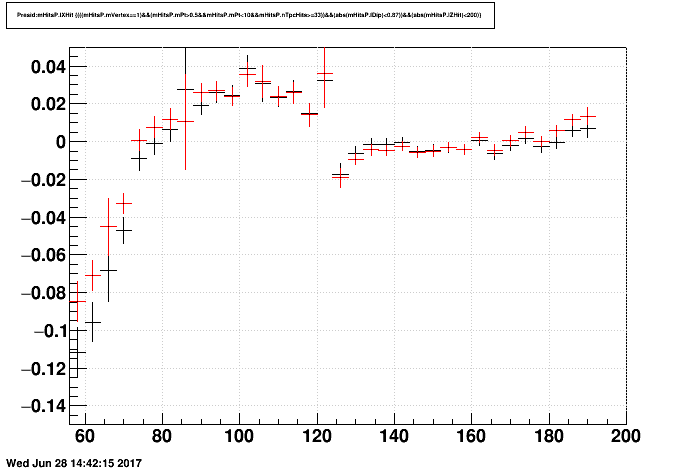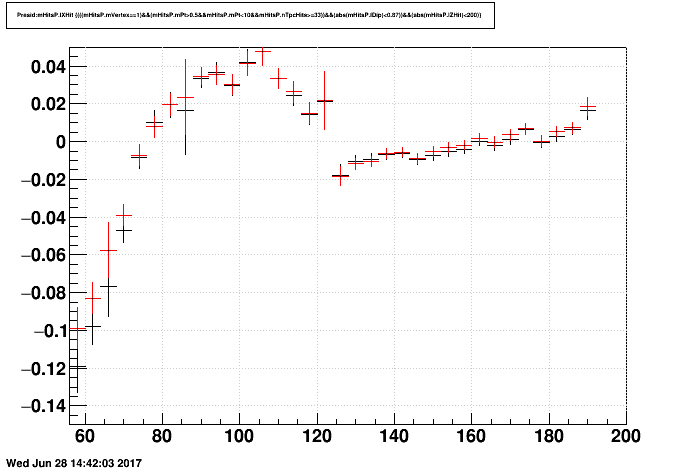- genevb's home page
- Posts
- 2025
- 2024
- 2023
- 2022
- September (1)
- 2021
- 2020
- 2019
- 2018
- 2017
- December (1)
- October (3)
- September (1)
- August (1)
- July (2)
- June (2)
- April (2)
- March (2)
- February (1)
- 2016
- November (2)
- September (1)
- August (2)
- July (1)
- June (2)
- May (2)
- April (1)
- March (5)
- February (2)
- January (1)
- 2015
- December (1)
- October (1)
- September (2)
- June (1)
- May (2)
- April (2)
- March (3)
- February (1)
- January (3)
- 2014
- 2013
- 2012
- 2011
- January (3)
- 2010
- February (4)
- 2009
- 2008
- 2005
- October (1)
- My blog
- Post new blog entry
- All blogs
GridLeak 3D vs. Full comparisons
Updated on Wed, 2017-07-05 13:58. Originally created by genevb on 2017-06-28 13:12.
Using 4th pass results from Matt Posik for calibration Run 17 pp510 using both OGridLeak3D (which has a single grid leak between the inner and outer sectors; 3D refers to it being non-cylindrical but rather 12-sided sheets) and OGridLeakFull (which has 4 separate grid leaks at the inner and outer edges of the inner and outer sectors [some people may refer to this as 3 grid leaks as the outer of the inner and the inner of the outer touch each other to form a single sheet in the volume of the TPC]).
From the calibration, the 3D calibration required a large GL value of 8.65, vs. 8.18 from the Full (~5% difference). The SpaceCharge calibration came out using different scalers:
3D: sc = (6.845e-08 +/- 1.695e-09) * ((zdcenk) - (6.103e+04 +/- 3775))
Full: sc = (7.718e-08 +/- 1.882e-09) * ((zdcwnk) - (4.927e+04 +/- 2627))
Looking at the RICH scalers ntuple with these two parameterizations shows that the Full calibration is about 7% higher at the lower end of luminosities acquired (zdcx = 200 kHz), and about 9% higher at the higher end of luminosities (zdcx = 400 kHz). So with the Full GridLeak, less GridLeak and more SpaceCharge are needed.
____
I looked at two runs that were used in the calibrations. One has small final sDCA values, while the other has large ones (i.e. the calibration doesn't do particularly well for that run):
Cuts on hits are as follows:
In 500 events, the calibrations find the following numbers of tracks passing the above cuts: Correction
I do not fully understand why these the globals and primaries aren't exactly the same, but of course the pT and η of the track can change slightly when going from global to primary and move a track in or out of a cut.
Here is a look at the along-the-padrow residuals from global tracks that have a primary partner (red) and the primaries (black), 3D is on the left, Full is on the right:


The next plots are residues vs. radius and z (with coarse binning):


For the not-so-well-calibrated run (18078026), I processed 2000 events, and here are those residuals:




What is apparent is something that still looks like a SpaceCharge + GridLeak distortion which hasn't been fully corrected. This represents the degree to which some runs are not properly corrected by the calibration we use; it shows the systematic errors left by the variance of runs from the calibration. These errors appear to be as much as 1 mm.
Coming back to the good run, here are the residuals vs. radius and sector for the two calibrations. Particularly obvious is that the Full GridLeak correction corrects more properly for sector 20 because the corrections are determined sector-by-sector to account for their above voltages.


___________________
Update (2017-07-05):
Here are the GridLeak δ(rφ) vs. r and z distortion maps for run 18075078 (the run with reasonably good DCAs) for 3D (left) and Full (right) GridLeak distortion corrections. The differences are almost imperceptible, perhaps to be expected.


-Gene
From the calibration, the 3D calibration required a large GL value of 8.65, vs. 8.18 from the Full (~5% difference). The SpaceCharge calibration came out using different scalers:
3D: sc = (6.845e-08 +/- 1.695e-09) * ((zdcenk) - (6.103e+04 +/- 3775))
Full: sc = (7.718e-08 +/- 1.882e-09) * ((zdcwnk) - (4.927e+04 +/- 2627))
Looking at the RICH scalers ntuple with these two parameterizations shows that the Full calibration is about 7% higher at the lower end of luminosities acquired (zdcx = 200 kHz), and about 9% higher at the higher end of luminosities (zdcx = 400 kHz). So with the Full GridLeak, less GridLeak and more SpaceCharge are needed.
____
I looked at two runs that were used in the calibrations. One has small final sDCA values, while the other has large ones (i.e. the calibration doesn't do particularly well for that run):
SC.Scan("run:dca:dcaw:dcae")
* Row * run * dca * dcaw * dcae *
3D:
* 4 * 18075078 * 0.0589640 * 0.0736607 * 0.0493333 *
* 5 * 18078026 * -0.266983 * -0.246764 * -0.305082 *
Full:
* 4 * 18075078 * 0.0272729 * 0.0302331 * 0.0173267 *
* 5 * 18078026 * -0.344899 * -0.326930 * -0.361877 *
Cuts on hits are as follows:
- Vertex:
- Is from (a global track associated with) a primary track from the Highest ranked primary vertex
- At least 10 daughters of that primary vertex are matched to fast detectors
- Track:
- 0.5 < pT < 10.0 GeV/c
- NTPC hits ≥ 33
- Dip angle < 0.87 (which is |η| < 1.0)
- Hit:
- Exclude hits near sectors' azimuthal edges
- Exclude prompt hits
- Exclude known post-crossing hits (z is wrong sign for sector)
In 500 events, the calibrations find the following numbers of tracks passing the above cuts: Correction
| Globals | Primaries | |
|---|---|---|
| 3D | 13474 | 13602 |
| Full | 13468 | 13605 |
I do not fully understand why these the globals and primaries aren't exactly the same, but of course the pT and η of the track can change slightly when going from global to primary and move a track in or out of a cut.
Here is a look at the along-the-padrow residuals from global tracks that have a primary partner (red) and the primaries (black), 3D is on the left, Full is on the right:


The next plots are residues vs. radius and z (with coarse binning):


For the not-so-well-calibrated run (18078026), I processed 2000 events, and here are those residuals:




What is apparent is something that still looks like a SpaceCharge + GridLeak distortion which hasn't been fully corrected. This represents the degree to which some runs are not properly corrected by the calibration we use; it shows the systematic errors left by the variance of runs from the calibration. These errors appear to be as much as 1 mm.
Coming back to the good run, here are the residuals vs. radius and sector for the two calibrations. Particularly obvious is that the Full GridLeak correction corrects more properly for sector 20 because the corrections are determined sector-by-sector to account for their above voltages.


___________________
Update (2017-07-05):
Here are the GridLeak δ(rφ) vs. r and z distortion maps for run 18075078 (the run with reasonably good DCAs) for 3D (left) and Full (right) GridLeak distortion corrections. The differences are almost imperceptible, perhaps to be expected.


-Gene
»
- genevb's blog
- Login or register to post comments
